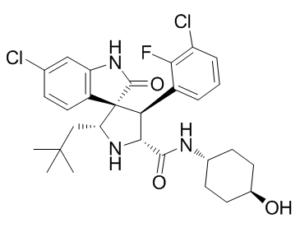MI-773 (2’S,3R isomer, SAR-405838)
This product is for research use only, not for human use. We do not sell to patients.

For small sizes, please check our retail website as below: www.invivochem.com
| Size | Price | Stock |
|---|---|---|
| 100mg | $1200 | Check With Us |
| 250mg | $2050 | Check With Us |
| 500mg | $3075 | Check With Us |
Cat #: V0021 CAS #: 1303607-60-4 Purity ≥ 98%
Description: MI-773 (2'S,3R isomer, SAR405838) is a novel, potent, specific and orally bioavailable small molecule antagonist of MDM2/piro-oxindole HDM2 (Murine double minute 2/human double minute 2) with a Ki value of 0.88 nM.
Top Publications Citing Invivochem Products
Publications Citing InvivoChem Products
Product Promise

- Physicochemical and Storage Information
- Protocol
- Related Biological Data
- Stock Solution Preparation
- Quality Control Documentation
| Molecular Weight (MW) | 562.50 |
|---|---|
| Molecular Formula | C29H34Cl2FN3O3 |
| CAS No. | 1303607-60-4 |
| Storage | -20℃ for 3 years in powder formr |
| -80℃ for 2 years in solvent | |
| Solubility In Vitro | DMSO: 100 mg/mL (177.77 mM)r |
| Water:<1 mg/mL (slightly soluble or insoluble)r | |
| Ethanol: 31 mg/mL warming (55.11 mM) | |
| SMILES Code | O=C([C@H](N[C@H]1CC(C)(C)C)[C@H](C2=CC=CC(Cl)=C2F)[C@@]31C(NC4=C3C=CC(Cl)=C4)=O)N[C@H]5CC[C@H](O)CC5 |
| Synonyms | SAR405838; SAR-405838; SAR 405838; MI773; MI-773; MI 773; MI-77301; MI 77301; MI77301; |
| Protocol | In Vitro | SAR405838 (MI-77301) potently inhibits cell growth in cancer cell lines, including SJSA-1 (IC50, 0.092 μM), RS4;11 (IC50, 0.089 μM), LNCaP (IC50, 0.27 μM), and HCT-116 (IC50, 0.20 μM) cells, and displays high selectivity over cancer cell lines with mutated or deleted p53, including SAOS-2 (IC50, >10 μM), PC-3 (IC50, >10 μM), SW620 (IC50, >10 μM), and HCT-116 (p53-/-) (IC50, >20 μM) cells. |
|---|---|---|
| In Vivo | At well-tolerated dose schedules, SAR405838 achieves either durable tumor regression or complete tumor growth inhibition in mouse xenograft models of SJSA-1 osteosarcoma, RS4;11 acute leukemia, LNCaP prostate cancer and HCT-116 colon cancer. Remarkably, a single oral dose of SAR405838 is sufficient to achieve complete tumor regression in the SJSA-1 model. In the SJSA-1 osteosarcoma, acute lymphoblastic leukemia RS4;11, LNCaP prostate cancer, and HCT-116 colon cancer xenograft model, MI-773 (p.o.) effectively inhibits tumor growth in a dose-dependent manner (10 mg/kg, 30 mg/kg, 50 mg/kg, 100 mg/kg, and 200 mg/kg,). |
These protocols are for reference only. InvivoChem does not
independently validate these methods.
| Solvent volume to be added | Mass (the weight of a compound) | |||
|---|---|---|---|---|
| Mother liquor concentration | 1mg | 5mg | 10mg | 20mg |
| 1mM | 1.7778 mL | 8.8889 mL | 17.7778 mL | 35.5556 mL |
| 5mM | 0.3556 mL | 1.7778 mL | 3.5556 mL | 7.1111 mL |
| 10mM | 0.1778 mL | 0.8889 mL | 1.7778 mL | 3.5556 mL |
| 20mM | 0.0889 mL | 0.4444 mL | 0.8889 mL | 1.7778 mL |
The molarity calculator equation
Mass(g) = Concentration(mol/L) × Volume(L) × Molecular Weight(g/mol)
Mass
=
Concentration
×
Volume
×
Molecular Weight*
The dilution calculator equation
Concentration(start)
×
Volume(start)
=
Concentration(final)
×
Volume(final)
This equation is commonly abbreviated as: C1 V1 = C2 V2
Concentration(start)
C1
×
Volume(start)
V1
=
Concentration(final)
C2
×
Volume(final)
V2
Step One: Enter information below
Dosage mg/kg
Average weight of animals g
Dosing volume per animal µL
Number of animals
Step Two: Enter the in vivo formulation
%DMSO
+
%
+
%Tween 80
+
%ddH2O
Calculation Results:
Working concentration:
mg/ml;
Method for preparing DMSO master liquid:
mg
drug pre-dissolved in
µL
DMSO(Master liquid concentration
mg/mL)
,Please contact us first if the concentration exceeds the DMSO solubility of the batch of drug.
Method for preparing in vivo formulation:
Take
µL
DMSO master liquid, next add
µL
PEG300, mix and clarify, next add
µL
Tween 80,mix and clarify, next add
µL
ddH2O,mix and clarify.
Note:
- (1) Please be sure that the solution is clear before the addition of next solvent. Dissolution methods like vortex, ultrasound or warming and heat may be used to aid dissolving.
- (2) Be sure to add the solvent(s) in order.




































